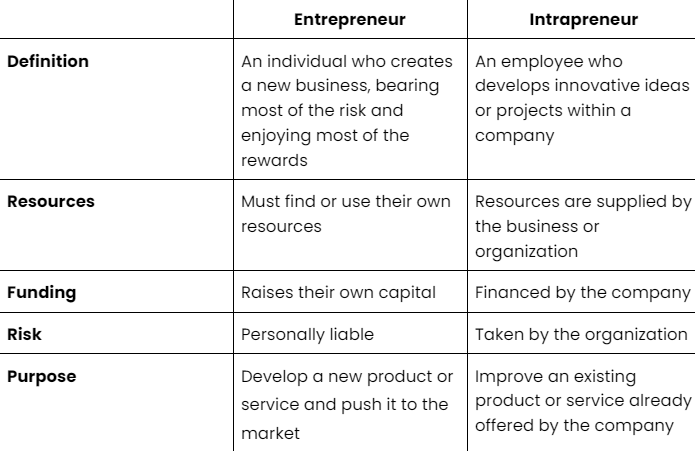What Is Intrapreneurship? Inspiring Ideas for Internal Innovation
You may already be familiar with the concept of an entrepreneur, but an intrapreneur is a less well-known term. And yet, in today’s business world, intrapreneurship may be just as important, maybe even more so. While there’s a minor difference in spelling between the two terms, the difference in meaning is much more significant.
As an entrepreneur myself, I’ve always believed that creativity doesn’t just belong to the founder’s office: it can (and should) live inside every team. That’s the essence of intrapreneurship. In this blog, I’ll share what intrapreneurship really means, why it matters, and some inspiring examples of how encouraging internal innovation can spark big wins and lasting growth.
What Is Intrapreneurship?
Intrapreneurs are employees who are incentivized to use company resources to develop innovative ideas and projects within a company. Think of them as entrepreneurs working from the inside out. These are people who spot opportunities and bring them to life without ever leaving their desks. While intrapreneurs are often overlooked within the realm of entrepreneurship, supporting internal innovation can be disruptive and bring about big change for a business.
That’s the beauty of intrapreneurship: it gives employees the freedom to dream big while still having the backing of their organization. Intrapreneurship combines the best of both worlds. They have the creativity and autonomy of an entrepreneur, with the resources, safety net, and support of a company that believes in their potential.
Entrepreneurship Vs. Intrapreneurship
Even though intrapreneurs are similar to entrepreneurs, there are some key differences to consider. At first glance, entrepreneurs and intrapreneurs may look like two sides of the same coin. Both are innovators. Both are problem-solvers. But the way they operate (and the risks they take) set them apart.
Here’s the real takeaway: entrepreneurs build from scratch, while intrapreneurs build from within. One bets on themselves, the other bets with the backing of a company. Both paths require vision and creativity; the difference is in who shoulders the risk.
How Does Employee Intrapreneurship Work?
Implementing an intrapreneurial model doesn’t happen overnight. To create a successful intrapreneurship program within your organization, leadership has to be intentional about change at every level, from the boardroom to the break room.
Here are some of the most effective ways to support intrapreneurship in your organization.
- At a strategic level: Intrapreneurship requires support from the top. It must start with organizational leadership making a strategic decision to support and foster internal intrapreneurs with their business. When executives give employees time, autonomy, and resources, they’re essentially saying, “We believe your ideas are worth investing in.”
- At a departmental level: Developing intrapreneurship starts with identifying those individuals within the organization who already have an entrepreneurial mindset and supporting them on a separate learning and development journey. Rather than following the traditional development paths, these employees should be allowed to develop in separate streams specially designed for intrapreneurs.
- At a managerial level: To encourage intrapreneurship, managers have to be more flexible with employees, allowing them to bend the rules that serve as barriers to innovation. This is where it gets uncomfortable, because intrapreneurs will test limits. But if managers can lean into that discomfort, the payoff is real innovation.
- At an individual level: High potential employees should be tasked with solving current challenges that the business faces. This allows them to work on solutions that are strategically aligned with business goals. Once the challenge has been presented, employees should be left to work autonomously on the solution and its implementation. Giving them ownership here doesn’t just solve problems. It builds confidence, loyalty, and a culture where bold ideas can thrive.
The Importance of Supporting Internal Innovation
Technological advancements are pushing organizations to innovate continuously to remain competitive. This can be seen in the current composition of Fortune 500 companies. Only 22% of companies on the 2015 Fortune 500 remain on that list today. The other 88% have been acquired, merged, or, in most cases, just lost relevance.
Supporting internal innovation is an important part of remaining competitive.One of the biggest advantages of intrapreneurship is that it taps into the people who already know your business inside and out. Employees understand products, processes, and culture better than anyone, which makes them uniquely qualified to spot opportunities others might miss.
A culture of internal innovation brings about other business benefits, such as:
- Attract high-quality talent: Showcasing the success of intrapreneurs within your organization will help attract high-quality talent to wish to use their entrepreneurial mindset within an established business.
- Boost employee motivation: Talented intrapreneurs will form productive and highly engaged teams to help them develop their ideas and bring them to life. As success stories emerge, employees will feel more motivated to be involved in these projects and contribute their own ideas and creativity.
- Remain competitive: Intrapreneurs usually don’t over-engineer and they don’t hang around. They like to develop and test their ideas as quickly as possible to find out what works and doesn’t. That intrapreneurial speed can push new products and services to market faster, helping your company gain the first mover advantage.
Here’s the truth: innovation doesn’t only come from Silicon Valley startups or lone entrepreneurs. With the right intrapreneurship mindset, your own employees can become the driving force behind your company’s next big breakthrough.
3 Inspiring Employee Intrapreneurship Examples
With so many examples of successful intrapreneurship, it’s hard to pick favorites. But if you’re wondering about the real advantages of intrapreneurship, these three stories show just how powerful internal innovation can be.
Blowing Competitors Out of the Water – Gmail by Google
Gmail is one of many shining examples of Google’s ability to foster internal innovation. Thanks to their legendary “20% time” policy (which encouraged employees to spend a portion of their week on passion projects), Paul Buchheit took a spark of an idea and ran with it. The result was Gmail. Today, Gmail has more than 1.5 billion global active users – a reminder of how one intrapreneurial idea can evolve into a cornerstone of an entire company’s success.
Playing with New Products – Playstation by Sony
Ken Kutaragi was a forward-thinking employee at Sony when he had the idea of expanding Sony’s services into the gaming market. Something his executives initially brushed off. After receiving backing from the CEO, Kutaragi was eventually allowed to work on the development of Sony’s first gaming console: the Playstation.
Ken Kutaragi eventually went on to become chairman and CEO of Sony Interactive Entertainment. By 2021, games and network services represented the largest share of Sony’s revenue, accounting for nearly 29% of the entire corporation. This is proof that one intrapreneurial idea can transform the future of a business.
Reaching Into New Markets – Flamin’ Hot Cheetos by Frito-Lay
Probably one of the most inspiring examples of intrapreneurship that came from the most unlikely of places. Frito-Lay employee Richard Montañez noticed a gap in the crisp market for a product that catered to Latino taste buds. He grabbed some unseasoned Cheetos and took them home to be seasoned with his homemade spice mix.
After bagging them up, complete with hand-drawn logos, he presented them to the board, who were more than impressed. Richard Montañez left his job that day as the company janitor and became the VP of MultiCultural Sales and Community Promotions. Flamin’ Hot Cheetos went on to become one of Frito-Lay’s most successful product launches ever. What a powerful case study in how to promote intrapreneurship in a company and unlock entirely new markets!
Take the Next Step Toward Supporting Intrapreneurship
Building a strong culture of internal innovation within your organization can help you attract better talent and improve business results. Intrapreneurship doesn’t just give you new ideas. It gives you an edge. It keeps your company agile, future-focused, and ready for the next opportunity.
Team building events complement these benefits and can help organizations improve the overall company culture. If you’re ready to see the advantages of intrapreneurship come to life, explore custom team building activities with TeamBonding, or browse our growing list of interactive and engaging events.
Get more insights in our newsletter:
* every subscription supports charity!
Plays well with these activities.


 Unlock exclusive resources for better teams. Every subscription supports charity!
Unlock exclusive resources for better teams. Every subscription supports charity!
Create Your Free Account
Get exclusive access to new programs from the TeamBonding Lab, save your favorite ideas, and track your upcoming events.
Already have an account? Login












